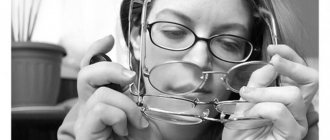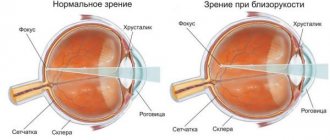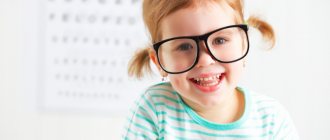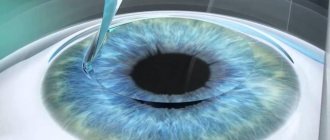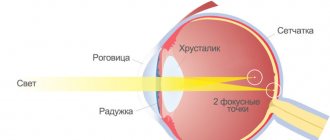What happens to vision with myopia?
Myopia is an ophthalmological disorder, which is often called myopia in everyday life.
In this article
- What happens to vision with myopia?
- Physiological causes of myopia development
- Why else can myopia develop?
- Retinal detachment is a consequence of high myopia
- Treatment of myopia more than 6 diopters
The name of pathology comes from the ancient Greek language. Translated from it, myopia is translated as “squinting your eyes.” The term “myopia” speaks for itself. A person with this refractive error sees objects that are close to them clearly. As they move away from the eyes, clarity is lost, objects appear blurry and foggy. Myopia occurs due to the fact that the focus of the image is “transferred” from the retina and is located in front of it. This is one of the types of ametropia - a visual pathology in which the refractive ability of the eyeball changes. The accommodative muscle is in a relaxed position, due to which the focus cannot reach the retina and is concentrated in front of it.
Review of modern methods of vision correction
In this article we will look at modern methods of vision correction and restoration, what are the pros and cons of each method. Which one is best for you?
Types of vision correction
Ophthalmologists distinguish 4 main methods of correction:
- Contact (lenses),
- Spectacle (glasses),
- Surgical,
- Laser.
Methods can be either temporary (for example, diopter glasses improve vision only while they are worn) or radical (laser correction can restore vision to its original level). The so-called crossover method is often used: lenses in the daytime + glasses in the evening, surgery + support glasses. Let's look at each method in more detail.
Spectacle vision correction
Glasses to improve vision are the oldest and simplest method of correction. Of course, over hundreds of centuries they have not only changed, but also received a lot of modern modifications. You can find out everything about glasses here.
The main function of diopter glasses is to correctly focus light rays on the retina, making the picture clearer. Wearing glasses is recommended in the following cases:
- High myopia (up to –30 diopters),
- High farsightedness (up to +10 diopters),
- Astigmatism (+/- 6 diopters),
- Childhood,
- Age-related farsightedness,
- Contact lens intolerance
- Contraindications to surgical or laser interventions.
There are also certain restrictions:
- Risk of injury (sports, active lifestyle),
- A field of activity that requires a full range of vision (for example, a pilot or a firefighter),
- A number of mental illnesses
- Anisometropia (large difference in diopters of the left and right eyes),
- Individual intolerance.
Glasses are the only correction method with additional functionality: the lenses protect the surface of the eye well from wind, dust, rain or bright sun. They are easy to use (you can take off and put on glasses at any time), do not require special care products (unlike lenses), are affordable and varied (you can choose several models - from the simplest to the stylish “go-out” one).
In some cases, prescription glasses are the only way to improve vision. For example, surgery is not recommended at an early age, and it is not possible to put lenses on a tiny child.
For presbyopia, double correction is possible - glasses are combined with special contact lenses.
The disadvantages of spectacle correction include:
- Limited visibility (glasses do not capture peripheral vision and distort spatial perception);
- Side effects (if selected incorrectly and/or worn for a long time, headaches, dizziness, and fatigue may occur);
- Unpleasant “special effects” (glasses fog up when the temperature changes, when there is snow or rain, drops settle on the glasses);
- Risk of eye damage (for example, from a fall);
- Limited activity (you cannot engage in contact and active sports with glasses).
For functional disorders, special glasses are used for correction.
Contact vision correction
According to patients, contact lenses not only improve vision, they help improve their quality of life. In just a few decades, this method of correction has changed beyond recognition. The first hard lenses had a whole list of dangerous side effects and were not intended for long-term use. Modern soft lenses made from a special hydrogel do not disrupt the normal blood supply to the eye, allow oxygen to circulate freely and are not felt at all on the eyes. Learn more about the pros and cons of contact lenses here.
Contact correction has a number of medical indications:
- High degree of farsightedness and myopia,
- Unsatisfactory result of spectacle correction or individual intolerance to spectacles,
- The difference in visual acuity is more than 2.5 diopters (left and right eye),
- Lack of lens (after injury, surgery or as a result of congenital pathology),
- Ablyopia (lazy eye),
- Professional testimony,
- Changing eye color (cosmetic correction for defects).
Soft (flexible) lenses are most often used, but for a number of diseases only hard options are indicated (for example, keratoconus).
In some cases, wearing contact lenses can cause complications:
- Red eye syndrome. Most often appears when using expired lenses, incorrectly selected optical power, poor hygiene
- Corneal erosion. The cause may be either a foreign body or damage to the contact lens itself.
- Corneal edema. It can occur with prolonged continuous wearing of lenses, hypoxia, or the use of toxic rinsing solutions.
- Follicular conjunctivitis. It is the result of wearing dirty lenses.
The possibility of using contact lenses should be determined by a specialist. When selecting, not only medical indicators are taken into account, but also the lifestyle, age and wishes of the patient. Contraindications include inflammatory processes, tear metabolism disorders, glaucoma, strabismus, lens subluxation and allergic reactions. What you need to know to select contact lenses.
Surgical methods for vision restoration
Modern ophthalmology offers minimally invasive surgical and laser correction methods. You can read a detailed review of surgical methods for treating eye diseases in this article.
All the pros and cons of laser correction are described here.
What is the price
Prices for glasses depend on the quality and brand of frames. The simplest models cost from 500 rubles. The price level reaches 10-15 thousand rubles, and this is not the limit. To get the full cost of the finished glasses, you need to add the price of the lenses and the work of the craftsman to the price of the frame (all together 1500-2000 rubles).
The price range of contact lenses is also wide, depending on the popularity of the brand. One-day ones will cost more (from 1000 rubles for 30 pieces). Two-week ones also start from 1000 rubles, but for 3 pairs, which is enough for 1.5 months.
Laser vision correction surgery costs from 15,000 to 50,000 rubles, depending on the complexity and type of operation.
Where to treat
Visual acuity is checked by an ophthalmologist, who can also select a correction option taking into account the patient’s wishes. Doctors also select glasses and lenses directly at the optician, where you can immediately purchase a suitable option.
Laser vision correction operations are performed by ophthalmologists in specialized clinics.
Bates and Norbekov exercises: is it really possible to improve vision without surgery?
Ophthalmologists say that many refractive errors could be avoided with proper eye care and following all preventive recommendations. Some doctors believe that the eye can be trained like any other muscle.
Palming is one of the relaxing exercises
The most famous techniques were developed by Bates and Norbekov. Among the patients who worked using their systems, there was a high percentage of improvement or complete restoration of vision. The main thing is not to forget that exercises may have contraindications (for example, the postoperative period or retinal detachment).
Doctors are unanimous: poor vision does not necessarily require surgical intervention. In most cases, hard work, performing relaxing and strengthening exercises, proper nutrition and vitamin intake, an active lifestyle and a properly organized work schedule work wonders. Spare no effort and time to take care of your eyes - then correction methods will not be required.
A working method to restore vision! You will throw your glasses in the trash in just 3 days...
Restoring vision. Real life story.
Physiological causes of myopia development
Ophthalmologists identify several reasons for the development of myopia. The most common among them is a change in the size of the eyeball. With myopia, it takes on an elongated shape and becomes oval.
Because of this, the retina of the eye is located behind the focal plane. Sometimes it happens that the refractive system focuses the rays more than required. For this reason, they do not converge on the retina, but in front of it. Myopia is characterized by a discrepancy between the optical power of the eye and its length. Often this refractive error is inherited. Congenital myopia is diagnosed in the first months of a baby’s life and is considered a serious pathology. The main reason for its development is a disruption in the formation of the eyeball during intrauterine development. Congenital myopia is more difficult to correct and progresses faster.
Why else can myopia develop?
Increased visual stress also leads to the development of myopia. Overworking of the eye muscles, writing or reading in low light - all this negatively affects the state of the visual system of the eye. The “peak” development of myopia occurs at school age. Typically, the load on the visual apparatus increases from 8 to 12 years. Parents need to closely monitor their child's vision and visit an ophthalmologist regularly. Some pathologies of the visual apparatus influence the development of myopia. These include:
- keratoconus;
- spasm of the ciliary muscle of the eye;
- subluxation of the lens.
Myopia can occur due to being addicted to gadgets, watching TV at close range, or playing games on a smartphone. The impact is caused by insufficient physical development of a person, lack of vitamins, and decreased immunity. During puberty, endocrine changes occur in the body, which can also contribute to the development of myopia. Unfavorable environment, poor nutrition, and inadequate sleep have a negative impact.
Prevention
You can prevent vision of minus 0.75 by maintaining eye hygiene and eliminating significant eye strain. It is important to minimize watching TV or sitting in front of a monitor. It is necessary to read or write so that the distance between objects and eyes is at least 30 centimeters, because in this position the load on the organ of vision is minimal and a person does not experience discomfort during prolonged work. Sufficient and non-irritating lighting is important. At the end of the working day, it is necessary to do eye exercises. This will help the extraocular muscles, the main one of which is the ciliary muscle, as well as relax and restore tone. You need to monitor your diet, saturate your diet with a sufficient amount of foods containing vitamin A, which is necessary for normal focusing.
What are the degrees of myopia?
Myopia can be congenital or acquired. In the first case, the symptoms of this refractive error appear from the first days of the child’s life. After birth, the baby is examined by an ophthalmologist. At that time, the newborn may be diagnosed with myopia. A person runs the risk of encountering the acquired form at any age. Depending on how quickly myopia develops, there are three degrees of this refractive error:
- weak (up to 3D);
- medium (from 3 to 6D);
- high (over 6D).
Myopia is also divided into true and false. In the case of diagnosing the first type, they speak of a change in the shape of the eyeball. In fact, this is the same myopia that many articles on the Internet are devoted to. For this reason it is called true. The second type is a spasm of accommodation, which occurs when the eye muscles are overworked. This condition is not myopia, since the eyeball does not change in size.
Causes of myopia
Why does myopia appear? This question is one of the most pressing for people who are faced with this pathology. There are several types of myopia, depending on which the cause of the disease is determined. For example, myopia can be hereditary or acquired. The first is most often diagnosed at the initial stage of life.
It develops if one of the parents has myopia. The causes of acquired myopia are different in nature: poor visual hygiene, an initially weak accommodative system, overexertion, etc. Myopia also develops due to damage to the cornea, and in this case the cause is the strong curvature of the cornea with its simultaneous strongly pronounced refractive power.
What characterizes low myopia?
The distance from the cornea to the central part of the retina is 23.5 mm. This meaning is typical for the visual organs of most people. With low myopia, the change in the length of the eyeball does not occur actively enough. Usually it is about 1.5 mm. This value is higher than normal, which is why doctors talk about a weak degree of refractive error. Deviation of length from the standard accepted by ophthalmologists adds 3D myopia. For people diagnosed with a mild degree of this refractive error, doctors prescribe optical products with optical power from -0.25D to -3D. With a low degree of myopia, a person sees objects close up well, but those located in the distance seem blurry to him.
Moderate myopia: what is it?
Moderate myopia is characterized by more significant changes in the visual apparatus. The length of the eyeball can be increased from 1.5 mm to 3 mm. A person clearly sees objects that are located at a distance of 20-30 cm from the eyes. The outlines of distant objects are greatly distorted. With moderate myopia, the blood vessels of the eyeball become thinner. Dystrophic lesions of the retina often begin to appear. If the doctor diagnoses moderate myopia, the patient is prescribed glasses or contact lenses to wear constantly. In some cases, oculists recommend ophthalmic products that are 1-2D less than required. This allows you to stabilize your vision for a while and slow down the development of myopia.
What to do?
The patient’s recovery also depends on the correctness of his diet.
If a person does not see, then it is important to eliminate the reason that caused this violation. Also normalize your daily routine with sufficient physical activity and proper rest. It is necessary to eat properly, consuming enough vitamins and minerals, especially fat-soluble A. You also need to avoid consuming fatty, fried and spicy foods. The use of mydriatics, antispasmodics and analgesic eye drops is indicated. If the measures taken are ineffective, laser vision correction is performed. With its help, the structure of the cornea is changed, and this helps to change the place where the rays converge in the pupil and the place of their focusing, which normally should be on the retina, but with myopia it moves in front of it. It is also possible to use hardware treatment, which is used to train accommodation and improve blood supply to the eye.
Drugs
Drug treatment for vision minus 5 involves the use of drops that have a mydriatic effect, which helps dilate the pupil. They help relieve spasm of accommodation and relax the muscles of the eye. Irifrin, Tropicamide or Atropine are used. In addition, vitamin supplements are indicated that improve nutrition and microcirculation of the blood vessels of the eyeball and promote rapid tissue regeneration. Taufon, Emoxipin, Blueberry Forte and other drugs will be useful.
Sometimes only one organ of vision suffers from myopia.
Surgical manipulation
Adult patients may be referred for laser surgery.
Vision minus 6 or 5 diopters is treated with surgery. Sclero-strengthening operations are used, for example, scleroplasty, which helps stop the process of vision deterioration and is carried out mainly in children with rapid progression of the disease. Laser vision correction also helps improve vision, but it has a lot of side effects and contraindications. The procedure is performed only on adults over 25 years of age, when eye growth has stopped, and also with normal corneal thickness.
Hardware therapy
If surgery is not possible, and drug treatment does not produce positive results, then hardware methods are used using various devices that improve blood supply and tissue regeneration abilities. This means that the disease can stop its development. Color pulse therapy, which affects the eyeball with pulses of different colors, has good properties. For this purpose, the Vizulon device is used, which acts as both a trainer and a vision stimulator. Also shown is work on the Amblyokor, Sinoptofor, Spekl-M, and Rucheek devices.
High degree of myopia: how many diopters?
A high degree of myopia from 6 diopters and above is the most dangerous. It can reach up to 30D. Serious changes occur in the structure of the eyeball. The retina and blood vessels become very thin. A person can only see at a distance of no more than 10 cm from the eyes. Reduced vision with a high degree of myopia is more than 90%. Correction of this form of refractive error is strictly necessary. High myopia is divided into non-progressive and progressive forms. In the first case, vision decreases by 1D per year. In the second, visual functions deteriorate much faster. If vision drops by more than 1D in a year, then doctors talk about a progressive form of myopia. A high degree of myopia can develop during adolescence. The eyeball grows very actively during this period. If myopia was diagnosed earlier, then in adolescence it can begin its rapid development. This form of refractive error is more difficult to correct with glasses or contact lenses. It often occurs with complications and causes a lot of inconvenience, for example, a burning sensation in the eyes.
Visual acuity in children
Parents always monitor and worry about their children’s vision, but it is not always possible to go to the doctor and conduct a full examination of their child’s vision. Therefore, the question of what visual acuity should be in children is one of the most asked questions on medical forums and websites on the Internet.
In children, from birth to school age, visual acuity changes significantly
At an early age, a child may have completely different vision, since the eyes are formed before the age of 18, and then in the older period it gradually deteriorates. Vision also changes its development under the influence of the environment, work schedule, and nutrition.
Normal vision in a child under one year of age
This age is considered the main period of vision formation. When a child is born, doctors do almost nothing, they only check the light reflex. Over the course of a month, vision begins to gradually respond to light and becomes more universal with each passing week.
By the end of the first year, the child begins to distinguish colors; understands where his parents are and where strangers are. If you suspect any eye disease, you should not be lazy and definitely go to the hospital.
The child’s vision should be developed from birth. The crib in which the baby sleeps should be in the brightest and lightest place in the house.
Normal visual acuity in children under 2 years of age
The vision of two-year-old children differs from that of a one-year-old child; it becomes more expressive, the baby can already determine the distance to objects and describe them. The child begins to boldly copy the parents’ facial expressions and movements.
After a year, the child’s visual acuity allows him to be interested in objects
At this age, the use of television, computer, telephone and other objects that create too much stress on the eye muscles is strictly prohibited. If you do not follow this rule, then you can expect not an improvement in vision in the future, but a significant deterioration.
Adjustable glasses for perfect vision! 50% discountNow you can adjust the diopters for your eyes yourself. Read more… |
Norm up to 3 years
During this period, the child can almost accurately describe the environment and report it to his parents. The most important thing at this age is to monitor the child’s conversation, because if he begins to speak clearly, then his vision is simply fantastic. And if he cannot start speaking for a long time, then most likely his vision is developing slowly.
At the age of three years, you can already start checking your baby’s visual acuity using Orlova’s table. But all this needs to be done by an ophthalmologist, since myopia may appear at three years of age.
Children may develop squinting. If your child starts squinting for no reason, then this is also a sign of myopia. However, the most important sign of myopia is a deterioration in the visibility of objects that are far away.
Visual acuity in children under 7 years of age
At the age of 7, a child’s visual acuity is already comparable to that of an adult and should be equal to 1. However, in the period from 5 to 7 years, a serious load is already placed on the child’s vision. At this time, all children attend kindergartens, schools, various sections and clubs, and therefore the eye muscles are subjected to a decent load.
During this period, you are allowed to watch TV and computer no more than an hour a day. The most important thing when watching is to take breaks every 15 minutes to relax your muscles, otherwise eye problems may occur.
Norm at 10 years
This is the age of puberty when hormonal imbalances and changes in metabolism occur, which can lead to myopia. From 7 to 15 years old, you need to carefully monitor the nutrition of children. The most important thing is that the child has enough vitamins “A”, “D”, “E”, “C”, because without these vitamins the body’s growth will occur rather slowly.
Summarize
As you understand, the visual acuity of children depends only on age. If we take statistics, we can determine the digital norm of vision:
- In fully grown people, namely 18 years of age and older, vision should be unity.
- In people over 50 years of age, vision may deteriorate, and the reason for this can be completely different criteria.
- But for children under 18 years of age, the norm is distributed quite differently. For a 3-year-old child, the norm is 0.6-0.9. At 5 years 0.8-1.0.
There are also statistics that vision reaches one only at 11 years old and about 80% of such children. And when vision reaches its maximum, then we can assume that your child’s visibility is simply excellent, and you should try to keep it at this level for as long as possible. For teenagers who graduate from school or enter various institutes, their vision may decrease slightly as the load reaches its peak.
Causes of high myopia
A high degree of myopia can be caused by a number of reasons. In medical practice, the following are most often encountered:
- metabolic disorder of the eyeball;
- diseases affecting visual acuity;
- high visual load.
Disorders of the metabolic processes of the eyeball are usually diagnosed in the maternity hospital. They can be determined using an ophthalmoscope or laboratory tests. Often, a high degree of myopia develops due to an abnormality in lipid metabolic processes. This includes amaurotic idiocy, which manifests itself when the baby reaches 4 months. The accumulation of lipids in the tissues of the fundus of the eye provokes compaction of the retina of the eye, staining its tissues yellow-gray in the area of the macula. This usually leads to strabismus, amblyopia and nystagmus, and in combination with a hereditary predisposition - to a high degree of myopia.
Bogart-Ebstein syndrome can also influence the rapid development of myopia. Low vision is its main symptom. The most dangerous complication of this disease is cataracts. This disease is often diagnosed in childhood. Sick people have very poor vision. Its decline occurs rapidly, and many of them have a high degree of myopia. Visual impairment is one of the important diagnostic signs of Niemann-Pick disease. Ultimately, this disease leads to complete blindness. Before this, it is characterized by a high degree of myopia.
Infections, hormonal changes in the body, and traumatic brain injuries, which impair microcirculation in the membranes of the eye, have an adverse effect on visual functions. A high degree of myopia often develops against the background of diabetes mellitus. In some cases, even short-term vision loss is possible. It is caused by fluctuations in sugar levels, which can cause the lens to change its shape.
What does better than 100% mean?
Imagine watching a movie at home on a computer with a small monitor. The film was found on the Internet, the image quality is not very good. Now imagine that you are watching the same film - but in the best cinema in the city. Clarity, contrast, color rendition – everything is completely different. You see close-ups of faces and the slightest emotions of the characters, you can see all the details of clothing, furnishings, and the landscapes will take your breath away... The result will be the same - you, of course, will see the film in both cases, but the sensations and pleasure received will be completely different. Or another situation. You are accustomed to high image quality on a monitor or plasma panel in your home. And come visit your grandmother, who flatly refuses to part with her old TV. You are sincerely surprised how your grandmother can even watch her favorite series in this quality! But she just doesn’t understand that it can be done differently. How many people do not realize that excellent vision is not only the ability to see objects in the distance. Vision better than 100% means qualitatively different characteristics: contrast, clarity, absence of distortion, light glare and glare, especially at night. Now, to feel that you see not just well, but to look at the world in a different quality, has become a real opportunity for those whom nature has “awarded” with myopia, farsightedness or astigmatism and who have decided to get rid of poor vision.
Retinal dystrophy as a complication of high myopia
With myopia of more than 6 diopters, degenerative changes in the retina occur. Degenerative-dystrophic changes lead to damage to photoreceptors, which are “responsible” for color and visual analysis. With retinal dystrophy, a person is concerned about the following symptoms:
- decreased visual acuity;
- violation of color perception;
- distortion of the outlines of visible objects;
- loss of night vision.
The danger of this condition is that with its development a person can become completely blind. For a long time, changes can occur asymptomatically. Often the patient learns about them when a significant percentage of vision has already been lost.
Vision 0.9, is this normal or not?
Hello, Kirill.
I think you have seen a special table in the ophthalmologist’s office, which depicts 12 rows of some letters of various sizes. This table is usually used to test distance visual acuity. To test vision, the patient sits 6 meters from the table, closes one of the eyes in turn, and the doctor asks the patient to name the letter indicated by him. If a person sees all the letters that are located in the 10th row of the table, then his visual acuity is 1.0. In the case when the patient is able to distinguish letters only in the 9th line of the table, his vision is 0.9, etc.
More details here
Naturally, a visual acuity of 0.9 is no longer normal, because your eye is no longer able to see what a person with a visual acuity of 1.0 can see. Of course, this situation is not critical, because... vision is not very much reduced. However, a drop in visual acuity may be a warning sign. The fact is that children aged 10 to 15 years often experience a sharp decline in vision . This occurs due to the rapid growth of the child’s body and the impact of heavy stress on the eyes. Unfortunately, vision loss is not always caused by age-related changes in a child’s body. This may be due to the impact of various unfavorable factors on the child’s body.
In some cases, decreased vision is caused by reasons that, at first glance, have nothing to do with the eyes. For example, vision may deteriorate in cases where there are lesions of the spinal cord and central nervous system, liver diseases, slagging in the body, adverse effects of environmental factors, infectious diseases, etc. Another reason for decreased visual acuity may be fatigue not only of the eyes, but of the entire body as a whole.
Naturally, when a child experiences a decline in vision, the obvious question arises as to what needs to be done to prevent vision from deteriorating even further. Of course, the best option is to visit an ophthalmologist, who can give advice on how to prevent further loss of vision. In cases where simple recommendations do not help to cope with decreased vision, special treatment may be prescribed, and sometimes surgical operations are indicated.
Now I will tell you about the basic recommendations that can help a person maintain his vision. Firstly, it is worth paying attention to where the student’s desk is located and where the light falls on it. The desk should be located in a bright place, but it is not advisable to place the desk right next to the window, because direct sunlight is very harmful to the eyes. It is advisable to move the table away from the window so that the light from the window falls on the left if the child writes with his right hand (and vice versa, the light falls on the right if the child is left-handed). If we talk about additional lighting, then on the desktop you can install a table lamp in the far left corner of the table. In this case, you need to take into account that its light does not fall directly into your eyes. The light of the lamp should be soft, it should not be too bright, and its shade should provide a soft dispersion of the rays. Under no circumstances should you read in the dark, do your homework only with a table lamp, and so on.
Read here
Secondly, one of the reasons for decreased vision may be a lack of vitamins in the body, so it is necessary to monitor proper nutrition and regularly consume foods rich in vitamins (especially vitamins A, B, C). It is believed that the most beneficial for vision are carrots, blueberries, spinach, berries and fruits, dried fruits, various vegetables, and dark chocolate.
read here.
Naturally, watching TV, as well as time spent at the computer, can have a very negative impact on the child’s vision, because the eyes become very tired. In general, school-age children are not recommended to watch TV more than 1.5 - 2 hours a day, and it is advisable to divide this time into several viewing sessions. It is also worth noting that you should not watch TV in the dark, because a sharp change in light and shadow is very unfavorable for the eyes, and the distance from a person to the TV should be at least 2 meters.
The time you work at the computer should also be limited, because... Children are not recommended to spend more than 1.5 - 2 hours a day in front of the monitor, while sitting at the computer continuously can be no more than 20 minutes (for the age of 10-11 years). If we talk about the total time spent on the computer and TV, it should also not exceed 2 hours. In between working at the computer or watching TV, you can do special exercises that help relieve eye strain.
More details here
and here.
Retinal detachment is a consequence of high myopia
A high degree of myopia often leads to retinal detachment. This is a pathology in which the retina of the eye separates from the choroid - the choroid. This condition is characterized by:
- a sharp decrease in vigilance;
- blurred vision in the evening;
- the appearance of a veil before the eyes;
- flickering of “flies” and “sparks”.
Retinal detachment is very dangerous. It is one of the main causes of complete blindness. Retinal detachment can only be treated with medication. Other methods will not give the desired effect. The only way to completely restore vision is to undergo surgery.
Risk of developing glaucoma with high degrees of myopia
Myopia of 6 or more diopters may cause increased intraocular pressure. This condition often leads to damage to the optic nerve and the development of glaucoma. The main symptoms of this disease include:
- narrowing of the field of view;
- feeling of pain and heaviness in the eyes;
- blurring of the image;
- decreased twilight vision.
If myopia is combined with glaucoma, then ophthalmologists talk about an advanced terminal stage of the pathology. Treatment of this disease usually begins with the prescription of antiglaucoma drops. With rapid progression of glaucoma, sclerectomy, iridotomy or trabeculoplasty are recommended.
Treatment of myopia more than 6 diopters
For people with a high degree of myopia, ophthalmologists recommend constantly wearing glasses or contact lenses. Doctors often resort to conservative therapy. This usually happens when the patient's condition is more or less stable. In such situations, ophthalmologists prescribe medications that improve the metabolism of the eyeball. These can be vitamin and mineral complexes, as well as injections of ATP drugs - mediators that excite adenosine receptors. For myopia greater than 6 diopters, ophthalmologists often prescribe laser vision correction. There are several methods of surgical intervention:
- LASIK;
- NASA LASIK;
- FemtoLASIK.
One of the methods of laser correction is photorefractive keratectomy. It was the very first surgical intervention performed using a laser. This method is also used in modern ophthalmology, but only for weak and moderate degrees of myopia. If myopia is more than 6 diopters, then photorefractive keratectomy will not be effective.
Operations to prevent the development of myopia
In some cases, doctors recommend surgery to prevent the progression of myopia. The purpose of this operation is to strengthen the posterior areas of the eyeball. For this purpose, the material of human fascia is used - the connective membranes that cover the vessels and nerves. Performing the operation in this way eliminates the risk of complications. Surgical vision correction is carried out in several stages. Surgery to prevent the development of high myopia is effective only in the absence of astigmatism.
